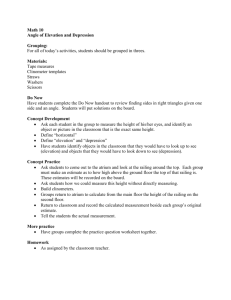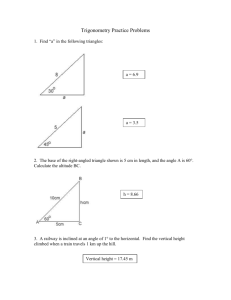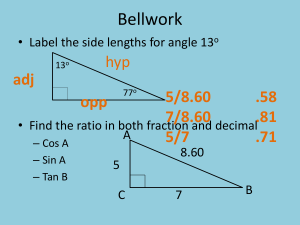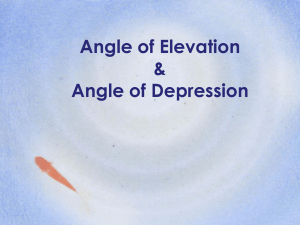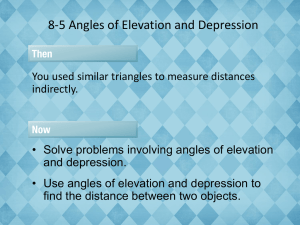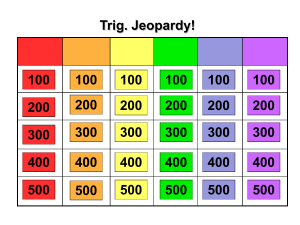Lesson 8-4(Word)
advertisement
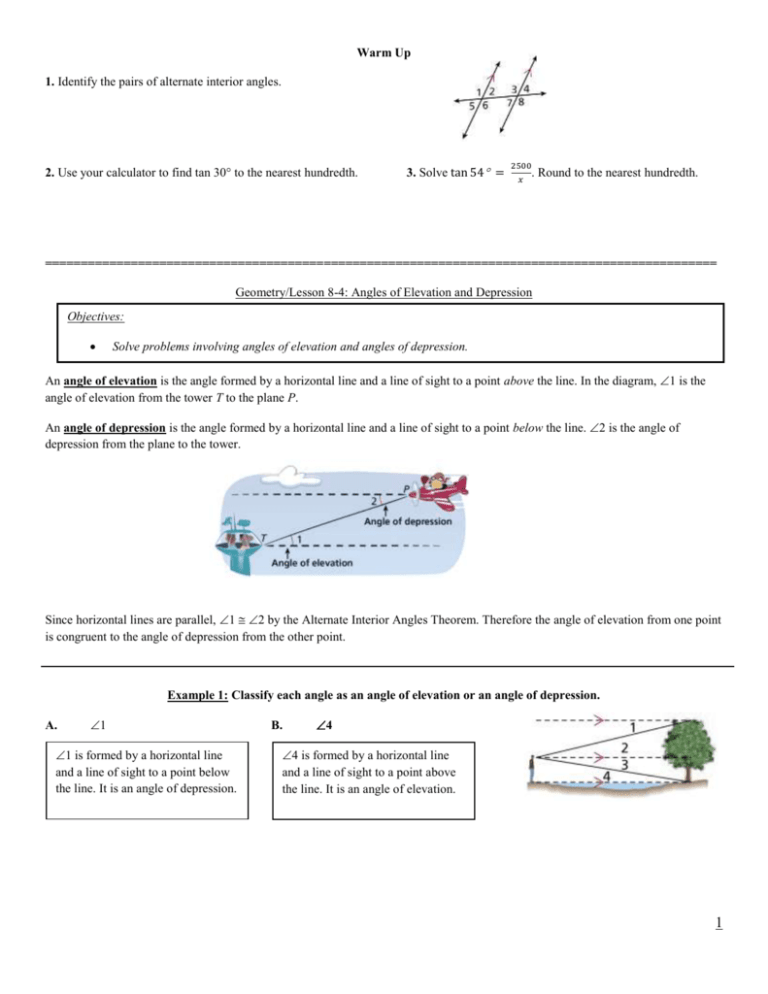
Warm Up 1. Identify the pairs of alternate interior angles. 2. Use your calculator to find tan 30° to the nearest hundredth. 3. Solve tan 54 = 2500 𝑥 . Round to the nearest hundredth. ============================================================================================== Geometry/Lesson 8-4: Angles of Elevation and Depression Objectives: Solve problems involving angles of elevation and angles of depression. An angle of elevation is the angle formed by a horizontal line and a line of sight to a point above the line. In the diagram, 1 is the angle of elevation from the tower T to the plane P. An angle of depression is the angle formed by a horizontal line and a line of sight to a point below the line. 2 is the angle of depression from the plane to the tower. Since horizontal lines are parallel, 1 2 by the Alternate Interior Angles Theorem. Therefore the angle of elevation from one point is congruent to the angle of depression from the other point. Example 1: Classify each angle as an angle of elevation or an angle of depression. A. 1 1 is formed by a horizontal line and a line of sight to a point below the line. It is an angle of depression. B. 4 4 is formed by a horizontal line and a line of sight to a point above the line. It is an angle of elevation. 1 C.I.O.-Example 1: Use the diagram above to classify each angle as an angle of elevation or angle of depression. 1a. 5 1b. 6 Example 2: The Seattle Space Needle casts a 67-meter shadow. If the angle of elevation from the tip of the shadow to the top of the Space Needle is 70º, how tall is the Space Needle? Round to the nearest meter. Draw a sketch to represent the given information. Let A represent the tip of the shadow, and let B represent the top of the Space Needle. Let y be the height of the Space Needle. C.I.O.-Example 2: What if…? Suppose the plane is at an altitude of 3500 ft and the angle of elevation from the airport to the plane is 29°. What is the horizontal distance between the plane and the airport? Round to the nearest foot. Example 3: An ice climber stands at the edge of a crevasse that is 115 ft wide. The angle of depression from the edge where she stands to the bottom of the opposite side is 52º. How deep is the crevasse at this point? Round to the nearest foot. Draw a sketch to represent the given information. Let C represent the ice climber and let B represent the bottom of the opposite side of the crevasse. Let y be the depth of the crevasse. 2 C.I.O.-Example 3: What if…? Suppose the ranger sees another fire and the angle of depression to the fire is 3°. What is the horizontal distance to this fire? Round to the nearest foot. 3° Example 4: An observer in a lighthouse is 69 ft above the water. He sights two boats in the water directly in front of him. The angle of depression to the nearest boat is 48º. The angle of depression to the other boat is 22º. What is the distance between the two boats? Round to the nearest foot. 3 C.I.O.-Example 4: A pilot flying at an altitude of 12,000 ft sights two airports directly in front of him. The angle of depression to one airport is 78°, and the angle of depression to the second airport is 19°. What is the distance between the two airports? Round to the nearest foot. Lesson Quiz: Part I Classify each angle as an angle of elevation or angle of depression. 1. 6 2. 9 Lesson Quiz: Part II 3. A plane is flying at an altitude of 14,500 ft. The angle of depression from the plane to a control tower is 15°. What is the horizontal distance from the plane to the tower? Round to the nearest foot. 4 4. A woman is standing 12 ft from a sculpture. The angle of elevation from her eye to the top of the sculpture is 30°, and the angle of depression to its base is 22°. How tall is the sculpture to the nearest foot? p. 565: 10-13, 15-21, 25 10) angle of depression 12) angle of elevation 16) 3.2 mi 18) True 20) True 5
